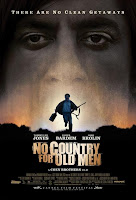
This movie was praised as the best movie of 2007. It was a multiple oscar candidate (and winner) and the latest work of the Coen brothers (also known from The Big Lebowski, Fargo and more). Is it good? Yes it is, but it is a moviemaker’s movie, if you catch my drift. It is the kind of movie that will be shown as course material for movie students but naive or innocent theatre guests might stumble bewildered from their seats.
At the start of the movie it resembles a slow, standard action movie about a person shooting other persons. But it becomes a tense movie as it progresses. The Coen brothers know what they are doing and have complete control over every single shot, the way Quentin Tarantino has, only less obvious. It is also a very silent movie. There is almost no music, because music makes a movie more approachable and that is not part of the Coen’s agenda. As a result the whole cinema was dead silent, fixated on the screen.
What the Coens set out to do, is toy with the expectations of the viewer. Some might interpret the result as bad filmmaking, but the directors did it on purpose. Time and again they set up scenes, only to let them end completely different as expected from wellknown movie tropes. Systematically they tackled all the conventions of regular action movies, until the viewer loses all grip on what is happening. And exactly the same thing is happening to the main character. As the old deputee Tommy Lee Jones mumbles tiredly about how the world has changed, and how it doesn’t make sense any more, we know what he means. The Coens made us feel exactly like him.
Jones sums it up in his final speech just before the end credits roll. This movie is a rough country, and it made you, like Jones, and old man, unable to handle what is happening and there is no father out there to help you out. It is no country for old men.
IMDB: No Country for Old Men





